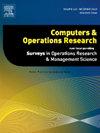基于预测模型的终身元学习多目标优化不可靠生产系统设计
IF 4.1
2区 工程技术
Q2 COMPUTER SCIENCE, INTERDISCIPLINARY APPLICATIONS
引用次数: 0
摘要
由于先进制造系统的实现,制造商通过设计决策来改进其工艺具有更大的灵活性。生产线的设计决策主要涉及两个复杂的问题:缓冲和资源分配。B&;RA的主要目的是确定生产线中缓冲区的最佳位置和大小,并将生产资源(如操作员和机器)优化分配到工作站。受船舶发动机生产行业真实案例的启发,本研究解决了高混合、小批量混合流车间(hfs)中B&;RA的前馈质量检测问题。这些hfs的特点是在需求、物料处理、加工时间和质量控制方面存在不确定性。在本研究中,生产环境是通过离散事件仿真来建模的,这反映了实际系统的特征,而不需要不合理或限制性的假设。为了取代昂贵的仿真运行,对仿真模型中采样的数据进行了五种广泛使用的回归机器学习算法的训练,并选择性能最好的算法作为预测模型。为了获得高质量的解决方案,该预测模型与增强型非主导排序遗传算法(En-NSGA-II)相结合,该算法结合了终身元学习,并具有自定义表示和可变邻域搜索的特点。此外,使用模式挖掘算法进行后最优性分析,以根据优化结果生成分配缓冲区和操作符的知识,从而提供有希望的管理见解。本文章由计算机程序翻译,如有差异,请以英文原文为准。
Predictive model-based multi-objective optimization with life-long meta-learning for designing unreliable production systems
Owing to the realization of advanced manufacturing systems, manufacturers have more flexibility in improving their processes through design decisions. Design decisions in production lines primarily involve two complex problems: buffer and resource allocation (B&RA). The main aim of B&RA is to determine the best location and size of buffers in the production line and optimally allocate production resources, such as operators and machines, to workstations. Inspired by a real-world case from the marine engine production industry, this study addresses B&RA in high-mix, low-volume hybrid flow shops (HFSs) with feed-forward quality inspection. These HFSs can be characterized by uncertainties in demand, material handling, processing times, and quality control. In this study, the production environment is modeled via discrete-event simulation, which reflects the features of the actual system without requiring unreasonable or restrictive assumptions. To replace the expensive simulation runs, five widely used regressor machine learning algorithms in manufacturing are trained on data sampled from the simulation model, and the best-performing algorithm is selected as the predictive model. To obtain high-quality solutions, the predictive model is coupled with an enhanced non-dominated sorting genetic algorithm (En-NSGA-II) that incorporates lifelong meta-learning and features a customized representation and a variable neighborhood search. Additionally, a post-optimality analysis using a pattern-mining algorithm is performed to generate knowledge for allocating buffers and operators based on the optimization results, thus providing promising managerial insights.
求助全文
通过发布文献求助,成功后即可免费获取论文全文。
去求助
来源期刊

Computers & Operations Research
工程技术-工程:工业
CiteScore
8.60
自引率
8.70%
发文量
292
审稿时长
8.5 months
期刊介绍:
Operations research and computers meet in a large number of scientific fields, many of which are of vital current concern to our troubled society. These include, among others, ecology, transportation, safety, reliability, urban planning, economics, inventory control, investment strategy and logistics (including reverse logistics). Computers & Operations Research provides an international forum for the application of computers and operations research techniques to problems in these and related fields.
 求助内容:
求助内容: 应助结果提醒方式:
应助结果提醒方式:


